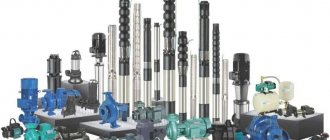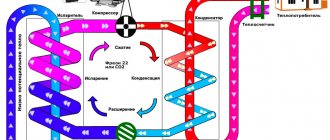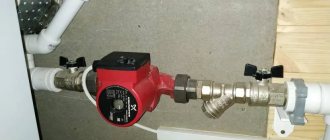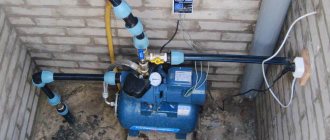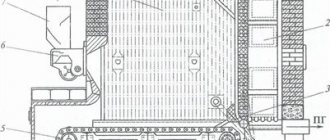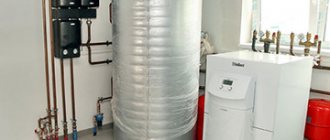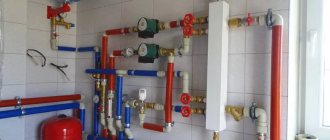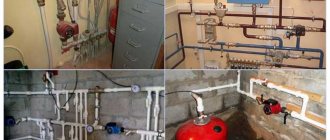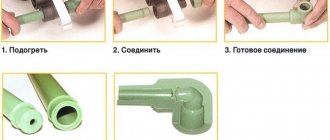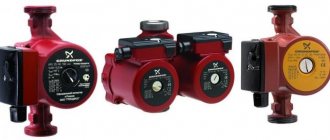To ensure stability in the operation of an autonomous water supply system, it is necessary first of all to correctly calculate the pump power. Let's look at what this parameter is, what are the criteria for choosing a pump, what main characteristics need to be calculated, what factors directly influence the calculation, what is the essence of the calculation method by measurement and calculation, and what are the main features of calculating the parameters of pumps of various types.
Each type of pump has its own power value and operating features Source cnp-center.ru
Pump power - what is it, criteria for choosing a pump, design parameters
Pump power refers to the amount of water pumped per unit of time. The value is expressed in liters or cubic meters. m per second and characterizes the performance or useful power of the equipment. In addition to this, there is power consumption. This is an indicator of consumed electricity, expressed in kW. The ratio of useful power to expended power reflects the efficiency factor. The higher its value, the less energy is lost for pumping water, and the more efficient the equipment is, accordingly.
When choosing a pump, the following series of criteria are primarily taken into account:
- Design and technical features.
Specific application conditions always require a pump of a certain design and specified technical parameters, the calculation of which can be performed in advance. In many cases, the choice of equipment is determined by the liquid supply technology. For example, if you need the most uniform pumping of water, then centrifugal models are used.
When the most uniform water supply is required, a centrifugal pump is used Source vseinstrumenti.ru
In other cases, or when technology also requires it, it is allowed to use piston units - providing water supply in portions. Another example of technical requirements is the case when the pump must or is forced to be located inside the source under the water surface. In this case, submersible models are used.
- Type of pumped liquid.
Pumping equipment must ensure unhindered pumping of a specific liquid medium. In private households, pumps are used not only to supply water from a well or well to the home water supply system.
Often, the owners of their home have to pump out cesspools and septic tanks, as well as pump out basements, plinths, and low-lying areas on the site during flooding. In addition, owners of swimming pools and artificial ponds also require a special pumping device. All these liquids can contain both small and large particles, and differ in viscosity and fluidity characteristics from ordinary clean water.
To pump out water with a large amount of impurities, a special type of pump is used Source jeelex-pumps.ru
- Main performance characteristics.
The main parameters of pumping equipment that affect its operation include:
- Performance.
- Pressure
- Power consumption.
To ensure long-term and reliable operation, the first 2 characteristics are taken into account first. As a rule, they depend on each other and determine the scope of application of the equipment. For example, a 1-stage centrifugal pump is capable of moving water up to 100 m, and according to calculations it will have a capacity of up to 1000 m³ per hour. At the same time, multi-stage models are capable of creating a head of up to 1000 m and a useful power of up to 10 thousand cubic meters. meters per hour.
Main design parameters
There are 3 main parameters that most accurately characterize the operation of pumps, these are:
- Performance.
The value is defined as the volume of pumped liquid in a certain period of time, for example, 1 liter per second. In practice, for example, in the water supply system of a private house, it should be equal to the total flow rate from all consumers - shower, sinks, bathtubs, etc.
The pump performance must be such as to satisfy all consumers in the house Source sovet-ingenera.com
However, the theoretical calculation does not take into account possible losses in the form of leaks due to the imperfection of the pipeline. Therefore, there is such a thing as actual consumption. Both quantities are related to each other by volumetric efficiency. It is necessary to take into account that modern devices and water supply systems - due to their high reliability and tightness - make it possible to equalize their values.
- Pressure.
Often this value is perceived as the height of the water column that the pump can create. In reality, this is not always the case. In theoretical calculations, the pump head represents the energy transferred to a unit mass of the pumped liquid medium.
The value is measured in meters and depends on several related factors. This is, first of all, the pressure difference between the point of intake and reception, the lift height, and flow resistance.
- Power consumption.
The characteristic shows the amount of energy expended by the pump to pump liquid. Its value is always higher than the useful power - the force directly expended on the supply of water.
Power consumption is usually indicated on the information plate of the device case Source cloudinary.com
In this case, a certain proportion of energy is spent on losses in pipelines, overcoming friction forces in mechanisms, etc. places. The difference between consumed and useful power is expressed by the efficiency factor.
Recommendation! To determine the pump power, you need to know the total water consumption in the house by summing up the value of each consumer. It is quite difficult to carry out such calculations in practice. Therefore, ready-made data can be taken from special tables. At the same time, the average daily rate per person does not exceed 200 liters.
Types by type of accommodation
According to the method of placement, water supply hydraulic pumps are divided into two classes:
- Surface type . Located away from the water source, they ensure its suction through a pipe lowered into a well or borehole.
- Submersible . They sink completely into the water to a certain depth.
pumping stations are classified into a separate class , which are essentially a compact, self-sufficient water-pressure complex consisting of a surface pump, a membrane accumulator tank, a water pressure switch and a control circuit.
Factors affecting the calculation
When calculating pump power, the following number of factors must be taken into account:
- Well depth.
An accurate determination of the parameter is necessary for the correct calculation of the source flow rate. Moreover, this will allow you to correctly select the pump according to the depth of immersion and the height of water rise.
- Static level.
This is the distance from the water surface to the surface of the earth when the water intake source is not in use. The downtime of the well before the start of measurement varies from 1 hour to a day.
For proper operation of the well, it is necessary to accurately determine the static and dynamic levels Source teployug.ru
See also: Catalog of companies that specialize in engineering systems (heating, water supply, sewerage and others) and related work
It reaches its maximum value during spring floods, and its minimum value during dry periods. Therefore, it is always better to measure it during the summer period without rain.
- Dynamic level.
This is the distance from the surface of the earth to the water surface at full water intake. The difference between static and dynamic levels is maximum in shallow wells - low-pressure sandy and low-flow Abyssinian wells, and is almost completely absent in deep artesian sources.
Determining the dynamic level when calculating the installation depth of a submersible pump is of great importance. Since the magnitude of the external pressure of the water column on the device in the off state will depend on this. In the optimal case, the equipment should be immersed at least 1-2 meters below the dynamic mark.
- Volume consumed.
In order to calculate the pressure and other characteristics of the installed pump, it is necessary first of all to determine how much water it will pump daily. The amount depends on the type and number of receivers, as well as how many people will use them. Each plumbing fixture has its own parameter value.
The volume of water consumed in the house depends on the specific type of consumer and their amount Source proekt-sam.ru
For example:
- Sink with tap – 250 l/h.
- Washbasin with mixer – 180 l/h.
- Bath with mixer – 300 l/h.
- Shower cabin – 115 l/h.
- Toilet with tank - 83 l/h.
However, in the calculations it is also necessary to take into account the utilization factor, which, as a rule, varies from 0.15 to 0.5 for different devices. In this case, the total consumed volume should not exceed the well flow rate.
- Diameter of well pipes or well rings.
For shallow narrow wells of the Abyssinian type, external centrifugal pumps with a submerged water intake pipe are used. Since it is not possible to install standard submersible models with a body diameter of 4 inches in them. They require a borehole pipe with an internal diameter of at least 100 mm.
For high-performance models with a 6-inch body, a pipe of at least 150 mm is required. If a well is used on the site as a water source, special requirements are also imposed on the diameter of the rings - subject to the installation of special submersible electric pumps with a float switch. The latter should be located on the water surface at least 300 mm from the central axis of the device.
Schematic illustration of a water supply system for a home Source 7filtrov.shop
- Water composition.
Depending on the type of water intake source, the composition of the water can vary significantly. Therefore, for each variety it is recommended to use its own type of pump, well suited to specific conditions:
- Inexpensive Abyssinian wells up to 8 m deep are serviced by vortex or centrifugal pump types. The pumped water is quite clean.
- Sandy springs are characterized by greater depth and the content of solid particles in the water. If the water is relatively clean, deep-well centrifugal pumps are used, and if there is significant turbidity, screw-type models are used.
- Artesian wells with a hard limestone bottom are serviced by vortex and centrifugal electric pumps.
At the same time, in order to accurately calculate the pressure and other important characteristics of the pump, it is necessary to take into account the hydraulic resistance factor in water filters. Since, due to poor water quality, they are often installed in the water intake system.
When calculating pump characteristics, it is necessary to take into account the hydraulic resistance of the water filter Source ichip.ru
Which one is better to choose?
Before choosing a water pump for your home, you should compare the advantages and disadvantages of their two main types:
| Surface pumps | Submersible |
| Installed permanently. Easier to maintain. | For repair and maintenance work, they require lifting from a well or well to the surface. |
| They need two pipelines: suction and discharge. | They work only for injection. |
| The maximum suction height is 10 m. The real one, taking into account losses in the pipeline and the reserve for lowering the water level in the well, is no more than 7~8 m. | Ascent from depths below 10 m. |
| They need to be filled with liquid before the first start-up or after repair work. | Ready to go immediately after diving. |
| There is a danger of the motor overheating during prolonged operation. | A pump immersed in water is cooled both by external water from the outside and pumped from the inside. |
| The need for winter preservation for the summer version of the water supply system. | For the winter, it is enough to drain the water from the system. |
| Work is accompanied by noise. | Silent. |
Calculation by measurement and calculation
To calculate the minimum force required to start a pump (or head), you need to know the performance (or flow) and the total velocity head, for which the following formula is used:
R = Main * P * Uvzh / 3960
P – water flow power, in horsepower (hp),
Main - total speed flow, measured in meters or feet,
P – productivity equal to water flow, measured in gallons/min (gpm),
UG – specific gravity of the pumped liquid, for water equal to 1,
3960 – correction factor.
To measure data, enter it into a formula and then calculate it, the following algorithm is used:
- The required flow rate is determined. The example considers a pump to irrigate a garden plot from a well, which requires 20 gpm.
When calculating power, the distance from the well to the tap, shower and other consumers must be taken into account Source: well24.moscow
- The vertical distance between the water intake point at the source and the receiver point is measured. For example, the distance between the water intake holes of a pump in a well and the watering point can be 30 meters, or translated into the English measurement system - 100 feet.
- The head loss due to thorn forces in the water supply system is estimated. Using a 1-inch plastic pipe as an example, about 6.3 feet of head is lost for every 100 feet of length. For example, the total length of the pipe, including the horizontal section, will be 150 ft. - the total loss will be about 9.5 ft. This takes into account losses on connections and transitions. If we assume that the pipeline will have 1 rectangular transition and 3 straight threaded ones, the value for this material will be 15 ft. Total 9.5 + 15 = 24.5 ft.
- The total feed height and losses are summed up. In this example – 150 + 24.5 = 174.5 ft. The resulting value corresponds to the value of Main in the above formula. This will be the minimum load that the pump motor must handle.
The more branches in the water supply, the greater the loss of pump power Source znatoktepla.ru
- The measured values are substituted into the above formula and the useful minimum pump power or water flow force in liters is then calculated. With. P = 174.5 * 20 * 1 /3960 = 0.88 l. With.
- The motor power value of the pumping equipment is adjusted taking into account the efficiency indicator. The latter, as a rule, varies in the range from 50 to 85% in modern models. If we take its minimum value as an example, we get = 0.88/0.5 = 1.76 liters. With.
Reference! The power of the pump motor can be indicated in both watts and horsepower. 1 l. With. = 746 W. In the above example, the device is 1.76 liters. With. corresponds to 1312 W, or 1.3 kW.
Connection diagram
Before describing the connection diagrams, let us recall such important characteristics of the pump as power; diameter; the possibility of soft start or the possibility of electronic control of the shaft speed; resistance to voltage surges; minimum and maximum immersion depth; pump diameter. Thus, the diameter of the pump is directly related to the price of the well: the smaller the diameter of the pump, the smaller the diameter of the pipe, which means its drilling will be cheaper.
The pump is connected through a pressure switch or through an automatic flow switch. Knowing the characteristics of the system and the pump, i.e. pressure and power that your relay will have to open, you can optimally select the right relay for the pump.
Some pump models provide protection against overheating and dry-running protection, but this is of an emergency nature only. When installing the system, it is worthwhile to provide your own dry-running protection system.
The disadvantage of systems that work with a pressure switch: between starts and stops of the pump, the pressure will always change, which will cause discomfort in using water in the shower. To avoid such inconvenience, you can purchase a pump with a frequency converter.
Pay attention to the maximum immersion depth of the pump: excessive depth will lead to pump failure
Video description
Video example of calculating pump power for heating:
The pressure value is calculated as follows:
- When there is a spare tank located above the pump. Rtr = Rgeo + Rloss + Rfree – Rheight of the tank.
- When the water source is below the pump. Rtr = Rgeo + Rloss + Rfree + Rheight of the source.
The performance of a surface-type pump is calculated using a standard method, taking into account a correction factor.
- Circulating.
A circulation pump is used to pump coolant in an autonomous heating system. For effective operation of the latter, particularly careful calculation of both the pressure value and the performance indicator is required.
Productivity is calculated using the following formula:
Ptr = Tneobh / (1.16 *Tout – Tin)
Ptr – required performance,
Тneobh – thermal power of the boiler,
Tout – Tin – temperature difference between the coolant at the outlet to the system and the inlet to the unit,
1,16 – specific heat capacity of water.
The pressure of the circulation pump is determined not by the difference in height between the source and the receiver, but by the value of the hydraulic resistance.
Privacy Policy
The Vodomaster.ru online store values the trust of its customers and takes care of keeping their personal data secret from scammers and third parties. The Privacy Policy is designed to ensure that personal information provided by users is protected from access by third parties.
The main purpose of collecting personal data is to ensure adequate protection of information about the User, incl. his personal data from unauthorized access and disclosure to third parties, improving the quality of service and the efficiency of interaction with the client.
.
GENERAL PROVISIONS
2.1. This Policy regarding the processing of personal data (hereinafter referred to as the “Policy”) was prepared in accordance with clause 2, part 1, art. 18.1 of the Federal Law of the Russian Federation “On Personal Data” No. 152-FZ of July 27, 2006 (hereinafter referred to as the “Law”) and describes the methods of use and storage by the Vodomaster.ru online store of confidential information of users visiting the vodomaster.ru website.
2.2. By providing the online store "Vodomaster.ru" with private information through the Site, the User freely, of his own free will, consents to the transfer, use and disclosure of his personal data in accordance with the terms of this Privacy Policy.
2.3. This Privacy Policy applies only to private information obtained through the Site. Personal information is information that allows, when used separately or in combination with other information available to the online store, to identify the client’s personal data.
2.4. The site vodomaster.ru may contain links that allow you to go to other sites. The online store is not responsible for the information published on these sites and provides links to them only to ensure the convenience of users. However, this Policy does not apply to other sites. Users who follow links to other sites are encouraged to review the privacy policies posted on such sites.
Video description
Video instructions for selecting a well pump:
The value is calculated using the following formula:
Rtr = (E * K + Ssum) / r * n
Rtr – required pressure,
E – friction losses,
K – maximum length of the pipeline, taking into account the distant heating device,
Ssum - the sum of safety factors for fittings, fittings, mixers and other elements,
p – coolant density,
n is the physical value of the acceleration of free fall.
- Centrifugal
In order to calculate the required flow of a centrifugal pump, you need to take into account the speed of the impeller - in fact, it will be equal to the difference in water pressure at the inlet and outlet into the cavity with the impeller. To calculate the theoretical value of the quantity, the following formula is used:
Nteo = y *s *cos a / n
y – peripheral speed,
c – speed of water movement,
cos a – cosine of the angle between the speed at the entrance to the working cavity and the peripheral speed,
n is the magnitude of the acceleration of free fall.
The theoretically calculated productivity is multiplied by the hydraulic correction coefficient (0.8-0.9) and the factor taking into account the number of blades (0.6-0.8). The pressure of the device is calculated in the same way as for analogues.
The most popular models of pumping units
Manufacturers offer a wide selection of equipment of different capacities, designed for pumping liquid media with various parameters. But we are only interested in flow-through models that operate in home heating and hot water supply networks.
How to distinguish circulation units from centrifugal and other types of pumps:
- in shape - the electric motor and impeller are installed in one housing, the pipes come out on the sides of the lower part (not in the middle);
- by the presence of a “wet” rotor, which significantly reduces the noise of impeller rotation;
- 2 standard sizes, installation length 130 and 180 mm;
- nominal diameter of the pipes is 15, 20, 25 and 32 mm, connection is coupling (threaded);
- nameplate pressure – 0.4, 0.6 and 0.8 Bar.
The specified parameters can be easily determined by the product labeling. Example: the numbers in the name Wilo Star-RS 15/4 indicate an internal diameter of the connecting pipes of 15 mm (DN 15) and a pressure of 4 m of water column (0.4 Bar). Example two: the Grundfos ALPHA2 25-60 device is connected to DN 25 pipes and develops a pressure of 0.6 Bar (6 meters).
Reference. Manufacturers usually release extended product lines. The German brand Wilo offers circulation blowers with a pressure of 2, 4, 6, 7 and 8 m of water. Art. But the “running” models still remain “fours” and “sixes”, less often – “eights”.
The design of a pump with a “wet” rotor
Of course, there are more powerful pumps, whose pressure reaches 1...10 Bar, but they are not used in private homes. Small units 130 mm long with ½ and ¾ inch pipes are usually installed inside boilers, large ones (18 cm, 1 and 1 ¼") are cut into the heating lines.
Briefly about the main thing
The useful power of a pump is characterized by the amount of water pumped over a certain period of time. The amount of energy spent on this work is defined as power consumption. The ratio of these values shows the efficiency of the pump. When choosing a pump, the design and technical features, type of liquid, and performance characteristics are taken into account.
The operation of a pump is characterized by 3 main parameters - performance, pump and power. When calculating power, the following number of factors are taken into account:
- Source depth.
- Static and dynamic level.
- Volume consumed.
- Diameter of pipes or rings.
- Composition of water.
- Height from source to receiver.
- Pressure in the water supply.
To calculate power, a special formula is used - P = Main * P * Uvzh / 3960, the values for which are measured in a special way. In private practice, the most commonly used types of pumps are surface pumps, submersible pumps, centrifugal pumps and circulation pumps. Calculation of pressure and productivity for each of them has its own specifics.
Inclusion in the water supply system
As mentioned above, ready-made pumping stations are more convenient to install and operate than others , the technical characteristics of which are suitable for supplying water to a small house for a family of 2~3 people or a summer house.
Connecting them comes down to a few simple steps:
- Choosing a location.
- Preparing a solid foundation.
- Laying out the necessary pipelines.
- The suction pipe lowered into the well must be equipped with a strainer and a check valve. It should be lowered to a depth no higher than 1 m from the surface of the water.
- Connecting the electrical network and protective grounding.
Buy a hydraulic accumulator for cold water
Hydraulic accumulator 100 l vertical LadAna (stainless steel flange)
Hydraulic accumulators, Vertical 7600.00₽
Hydraulic accumulator 100 l vertical with pressure gauge LadAna
Hydraulic accumulators, Vertical 7920.00₽
Hydraulic accumulator 100 l horizontal LadAna (stainless steel flange)
Hydraulic accumulators, Horizontal 7600.00₽
